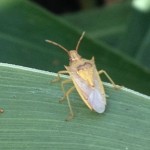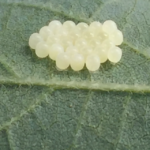Harvest has begun for both grain sorghum and corn. Thus far I have heard reports of sorghum yield ranging between 6000 and 7500 lbs/acre.
Sugarcane aphids continue to be found in sorghum fields in relatively low numbers. This insect can reduce yield until hard dough. The aphid can contribute to harvest difficulty after black layer by producing sticky honeydew. The honeydew can stick plant material together as it goes through the combine. In worse cases, this can clog the feeder or cause grain to pass out of the combine.
Stink bugs are beginning to show up in both cotton and soybean fields. This may increase as grain harvest continues and the stink bugs leave the harvested fields to other food sources.
Stink bug identification can be important when determining when to treat a field. For example, if Rice Stink Bugs are found in a cotton or soybean field, they should not be counted as a pest as they are primarily grass feeding stink bugs and do not contribute significantly as a cotton or soybean pest. Two pages for stink bug ID are HERE and HERE
Cotton fields should be checked for evidence of feeding in 1-inch bolls. To check for evidence of feeding, pull 50, 1-inch bolls off of cotton plants from several places in a field. These bolls should be popped open to look for wart growth on the internal boll wall, or discoloration on the lint or seed. The economic threshold for stink bugs in cotton is when more than 20% of the 1-inch cotton bolls have evidence of internal feeding.
In soybeans, check for stink bug using either a sweep net or a drop cloth. When sweeping fields, be sure the sweep net passes through the plant where the soybeans are developing. I tend to sweep the net below the top 6 inches of the plant. If done properly, this will damage plants. I usually make 10 passes with the sweep net across the row, then check the net for insects. I will often take 4-5 samples of 10 sweeps at each of 4-5 locations in a field.
When sampling with a drop cloth, shake the plants on either side of the row over the sheet and check for bugs. this should be done at 10-15 places per site at 4-5 sites per field.
Stink bug economic thresholds in soybeans are when more than 36 stink bugs are found per 100 sweeps (1 per foot of row with a drop cloth). If red banded stink bugs make up a significant part of the sting bugs collected, treat when more than 12-16 bugs are found per 100 sweeps or 1 per 2-3 feet or row with a drop cloth.
Other pests in Cotton include bollworms and verde plant bugs. Verde plant bugs can be found and treatment is warranted when more than 20-25 bugs are found per 100 plants. This pest will also be detected by checking for internal boll feeding for stink bugs as it can cause the same kind of injury. The latest planted cotton is in bloom and is no longer vulnerable to cotton fleahopper causing yield loss.
Bollworms are being found in many Bt cotton fields. Treatment may be needed when more than 5000 worms larger than 1/4 inch are found.


